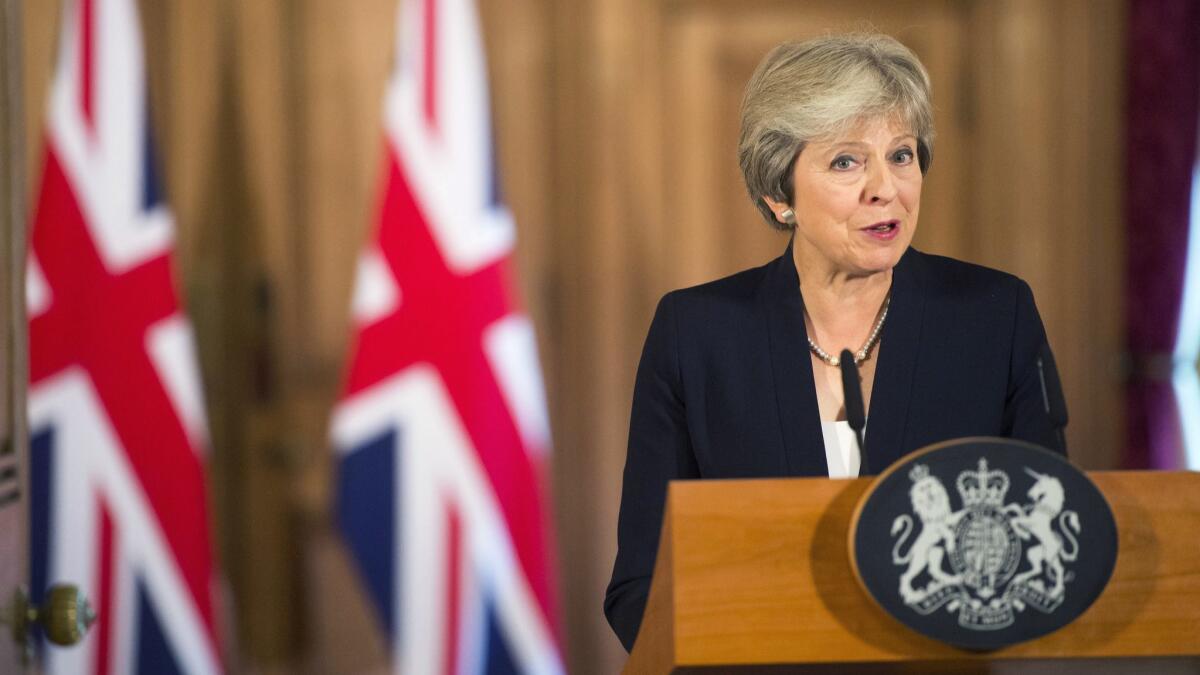With ‘Brexit’ talks at an impasse, Britain’s Theresa May and EU leaders blame each other

- Share via
Reporting from LONDON — British Prime Minister Theresa May challenged the European Union on Friday to break the impasse in “Brexit” negotiations after EU leaders threw talks into doubt by labeling May’s blueprint for leaving the alliance unworkable.
With British newspapers declaring that May had been “humiliated” by EU leaders at a summit in Salzburg, Austria, the prime minister used a televised statement at her official residence at 10 Downing St. to confront the EU over its position.
“At this stage in the negotiations, it is not acceptable to simply reject the other side’s proposals without a detailed explanation and counter-proposals,” May said.
Declaring that “we are at an impasse,” she said the EU must lay out “what the real issues are and what their alternative is.”
“Until we do, we cannot make progress,” May said.
The British pound fell after May’s comments, which seemed to make the prospect of an economically disruptive “no deal” Brexit more likely. The currency was down in trading a sharp 1.5% on the day, closing at $1.31.
May’s combative statement followed a fraught Salzburg summit, at which European Council President Donald Tusk said parts of Britain’s exit plan simply “will not work.” French President Emmanuel Macron called pro-Brexit U.K. politicians “liars,” saying they had misled the country about the costs of leaving the 28-nation bloc.
A rattled May insisted that her plan was the only one on the table — and that Britain was prepared to walk away from the EU without a deal if it was rejected.
“Throughout this process, I have treated the EU with nothing but respect,” she said Friday. “The U.K. expects the same. A good relationship at the end of this process depends on it.”
The rocky EU summit dashed British hopes of a breakthrough in stalled talks, with just six months to go until Britain leaves the bloc on March 29.
The judgment of British newspapers was harsh. The pro-EU Guardian said May had been “humiliated.” The headline in the conservative Times of London said: “Humiliation for May as EU rejects Brexit plan.”
The Brexit-supporting tabloid Sun branded alliance leaders “EU dirty rats,”calling Tusk and Macron “Euro mobsters” and accusing them of “ambushing” May.
Despite all the heated British rhetoric, the EU’s position is not new.
May’s “Chequers plan” — named for the prime minister’s country retreat where it was hammered out in July — aims to keep Britain in the EU single market for goods but not services, in order to ensure free trade with the bloc and an open border between the U.K.’s Northern Ireland and EU member Ireland.
EU officials have been cool on the plan from the start, saying Britain can’t “cherry-pick” elements of membership in the alliance without accepting all the costs and responsibilities.
Yet British politicians and diplomats were taken aback by Tusk’s blunt dismissal of the Chequers plan on Thursday — and by his lighthearted Instagram post showing him and May looking at a dessert tray and the words: “A piece of cake, perhaps? Sorry, no cherries.”
U.K. Brexit Secretary Dominic Raab said the bloc had “yanked up the hand brake” on the negotiations.
But anti-Brexit activist Gina Miller said British officials shouldn’t have been surprised. She said the EU had “made it very clear where they stand, and the U.K. has been so focused on its own infighting that they actually have not been listening.”
Tusk said Thursday that an EU summit on Oct. 18-19 would be the moment of truth, when an agreement on separation terms and the outlines of future trade would be sealed or would fail.
The biggest single obstacle to a deal is the need to maintain an open Irish border. Failing to do so could disrupt the lives of people and business on both sides, and undermine Northern Ireland’s hard-won peace.
Britain and the EU have agreed on the need for a legally binding backstop to guarantee there is no return to customs posts and other border checks. But Britain rejects the EU’s proposed solution, which would keep Northern Ireland inside the bloc’s customs union while the rest of the U.K. leaves.
In her statement Friday, May said she would “never agree” to “any form of customs border between Northern Ireland and the rest of the U.K.”
“If the EU believe I will, they are making a fundamental mistake,” she said.
Dealing with the EU is only part of May’s problem. Her Chequers plan also faces opposition from pro-Brexit members of her Conservative Party, including former Foreign Secretary Boris Johnson, who say it would keep Britain tethered to the bloc, unable to strike new trade deals around the world.
The Salzburg summit has given Britain’s pro-Brexit politicians new energy. When the Conservatives meet for their annual conference on Sept. 30, they plan to push May to ditch the Chequers plan or face a challenge to her leadership.
Pro-EU politicians don’t like the Chequers plan either, saying it would cut the U.K.’s vast services sector out of the EU’s single market.
Despite the standoff, May hinted there could be a way forward.
“We need serious engagement on resolving the two big problems in the negotiations” — trade and the Irish border, she said. “We stand ready.”
More to Read
Sign up for Essential California
The most important California stories and recommendations in your inbox every morning.
You may occasionally receive promotional content from the Los Angeles Times.













